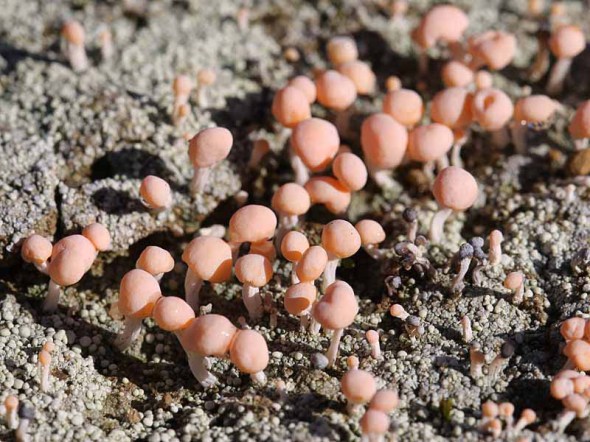Pink Earth
 You’ve probably walked right over this lichen a million times and perhaps even thought it was a fungus. To all appearances, Dibaeis baeomyces appears to be colonies of tiny, pink mushrooms, but in fact, those aren’t mushrooms – they are the fruiting bodies, or apothecia, of a lichen (fungus + alga or cyanobacterium) known as “Pink Earth.” If you look closely at these 1/8” bubblegum-colored structures, you’ll see that they are at the apex of tiny stalks that grow out of a gray crusty matter, which is actually the body, or thallus, of the lichen. Look for Dibaeis baeomyces growing in disturbed areas such as roadsides.
You’ve probably walked right over this lichen a million times and perhaps even thought it was a fungus. To all appearances, Dibaeis baeomyces appears to be colonies of tiny, pink mushrooms, but in fact, those aren’t mushrooms – they are the fruiting bodies, or apothecia, of a lichen (fungus + alga or cyanobacterium) known as “Pink Earth.” If you look closely at these 1/8” bubblegum-colored structures, you’ll see that they are at the apex of tiny stalks that grow out of a gray crusty matter, which is actually the body, or thallus, of the lichen. Look for Dibaeis baeomyces growing in disturbed areas such as roadsides.
Naturally Curious is supported by donations. If you choose to contribute, you may go to http://www.naturallycuriouswithmaryholland.wordpress.com and click on the yellow “donate” button.


















Wow! I’ve never noticed it!
November 18, 2013 at 2:19 pm
I argue that those are indeed a fungus.
November 18, 2013 at 10:38 pm
Afraid not, Jean! But for sure confirm that for yourself.
November 19, 2013 at 1:43 am
from Wikipedia online:Lichens pose a problem for biological classification, because the three types of organism concerned come from three different kingdoms. After long debate, lichen are now classified as fungi, under the genus and species of the host fungus.[2]p47–48 This allows specimens to be put into boxes and labelled. By having specific names, researchers know what they are working on: that is one of the basic functions of taxonomy. The system still has its problems. In those fungi which may associate either with an alga, or with a cyanobacterium, the resulting forms (called photomorphs) may look quite different, yet are now referred to by the same name.[2]p13
20% (one in five) of fungal species live in lichens. Lichen fungi belong to several different groups of fungi. Most common (over 40%) are Ascomycetes, which produce spores in a sac-shaped container, the ascus. Only a few types of alga occur within lichens; these algae also have their own names. Algae may be sometimes the dominant partner in so-called ‘jelly lichens’, Collema and Leptogium, but this is rare. More usually, the algae are the green alga Trebouxia. Other species are the orange Trentepohli, and the cyanobacterium Nostoc.[2]p9–10
November 19, 2013 at 5:51 am